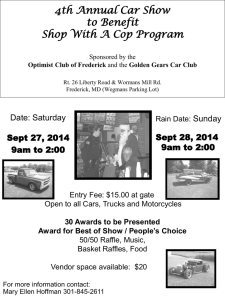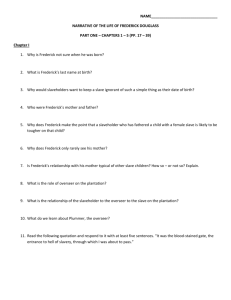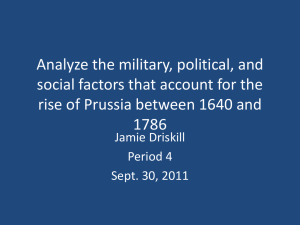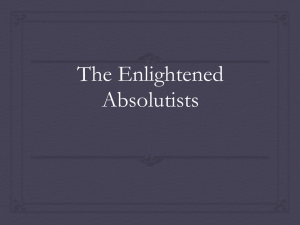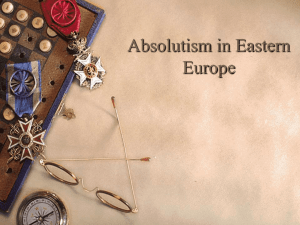Narrative 3
advertisement
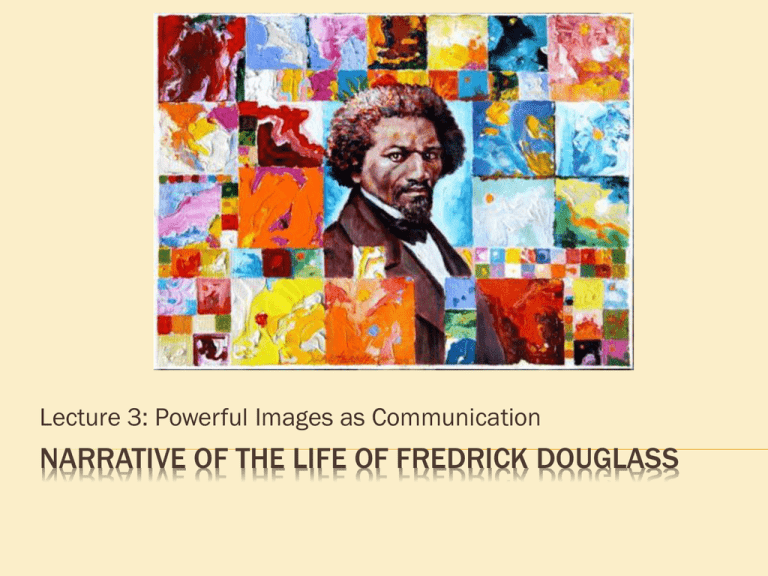
Lecture 3: Powerful Images as Communication NARRATIVE OF THE LIFE OF FREDRICK DOUGLASS FIRST IMPRESSIONS IMAGES: POWERFUL COMMUNICATION Images are able to convey information quickly and evoke deep emotions in their viewers. This power of the image derives from its ability to convey a message all-at-once, as a gestalt or whole chunk of meaning. The way the brain processses images also contributes to their power: we can see, remember, and be moved by an image that we have not really thought about. It can enter into consciousness below our analytical radar--or be moving too quickly--and continue to influence us from our subconsciousness. "Images and Propaganda." Media-Studies@ca :: Home. 12 Jan. 2012. Web. 12 Jan. 2012. <http://www.mediastudies.ca/articles/images_propaganda.htm>. VISUAL COMMUNICATION: ANALYSIS THE OLD PLANTATION (ANONYMOUS) 1777 What is the mood of the sketch? What is the setting in the sketch? What is the action in the sketch? What is the story of the sketch? Look at the details of the painting. Write down five details that support the pro-slavery propaganda VISUAL COMMUNICATION: ANALYSIS THE OLD PLANTATION (ANONYMOUS) The Old Plantation. Anonymous folk painting, South Carolina, c.1777-1794 VISUAL COMMUNICATION DISCUSSION Planters romanticized life on the plantation, often representing themselves as stern but loving parents who had to look after their slaves, who were depicted as childlike and in need of disciplined guidance. The plantation as the perfect extended family was a common theme of pro-slavery paintings both before and after the Civil War. In reality, of course, the harsh life of a slave bore little resemblance to this romanticized image. VISUAL COMMUNICATION ANALYSIS ‘THE HUNTED SLAVES’ BY RICHARD ANSDELL 1861 What is your first emotional reaction to the painting? What is the setting in the painting? What are the emotions of the people in the painting? What is the story of the painting? Look at the details of the painting. Write down five important anti-slavery images. VISUAL COMMUNICATION ANALYSIS ‘THE HUNTED SLAVES’ BY RICHARD ANSDELL 1861 VISUAL COMMUNICATION: DISCUSSION 'The Hunted Slaves'painted by Richard Ansdell 1861. Painted in 1861 ,the year of the American Civil War broke out,this dramatic picture shows two runaway slaves struggling for both their freedom and their lives. They are turning to face the dogs that have been set on them. These animals could be seen as symbols of their white 'masters' but the escapees also face new dangers from their surroundings. A snake can be seen emerging from the bushes behind the woman. The man is shown as graceful, heroic and virile figure. ASSIGNMENT 3: CHAPTERS 5&6 Chapter 5 1. What was life like for Frederick on the plantation? 2. Why was Frederick so happy to be leaving the plantation? 3. Why did he particularly want to go to Baltimore? 4. What relationship did his new master have to his old master? 5. Why did Frederick, who was seven or eight, not know the month or year of his sailing? 6. What were Frederick’s initial impressions of his new mistress, Mrs. Sophia Auld? ASSIGNMENT 3: CHAPTERS 5&6 Chapter 6 1. To what does Frederick attribute the kindness of Mrs. Auld? 2. What, according to Frederick, changes her? 3. Why is Mr. Auld angry when he finds that Mrs. Auld is teaching Frederick his letters? 4. Why does Frederick call Mr. Auld’s forbidding his learning how to read “invaluable instruction” (p. 49)? (Education) * 5. Why does inability to read keep men enslaved according to Frederick and to Mr. Auld? (Education) 6. What does Frederick hope to gain by learning how to read? 7. Who teaches Frederick why black men are not taught to read? 8. Why is this lesson so important to him? 9. Why is the life of a city slave so much better than the life of a plantation slave? 10. Why does Frederick relate the story of the slaves Henrietta and Mary? (English)
